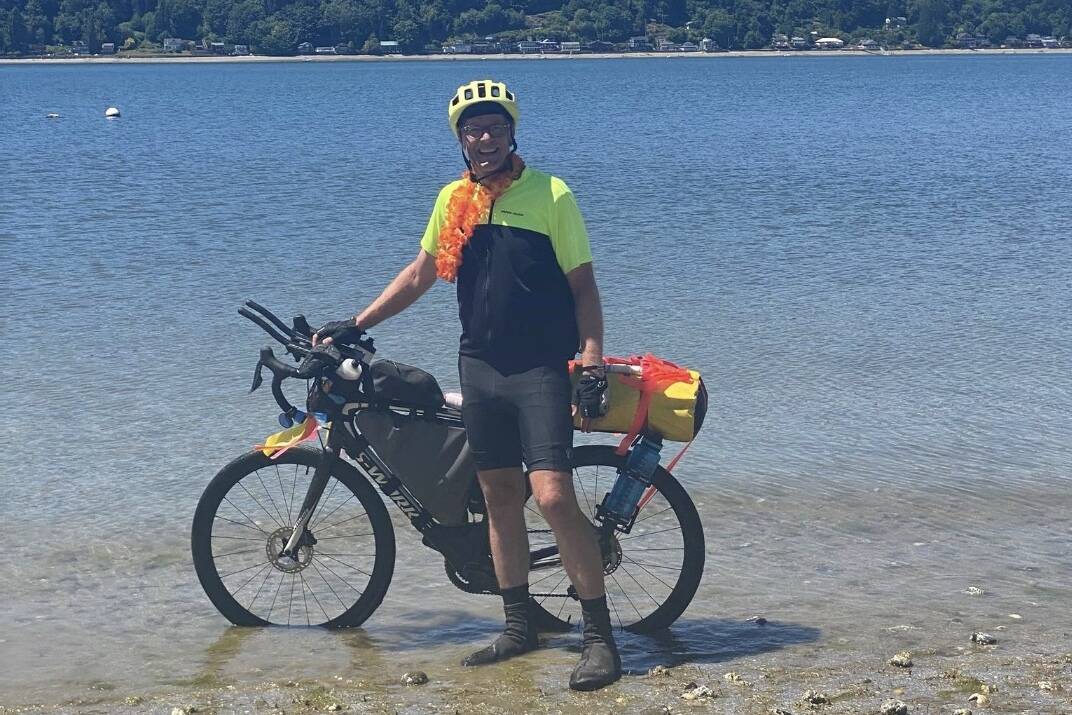When Vashon islander Mark McKallor was a little boy, he dreamed of riding his bicycle across America. Well, not exactly — little boys dream of riding their bikes to the other side of town, not across the country.
But as hard-core cyclists grow older, they know that there is a cross-country challenge out there calling their name. The particular challenge that Mark selected is called the “Northern Tier” route, which takes cyclists across the northern contiguous United States from Maine through Washington. It is the same route that Bruce Morser and Bob Horsley (friends and rowing club teammates) completed in 2017.
A first big decision for any cross-country rider is which direction to go. With the earth spinning counterclockwise, as viewed from above the north pole, you might think that the winds would blow from the east — but that is not correct. Because of the phenomenon known as the Coriolis effect, the wind patterns are from west to east. So to have the wind at your back, you want to ride that direction. But that also means that in the mornings, the sun is in your eyes and also in the eyes of overtaking drivers.
And thus, Mark chose to fly to Boston, depart from the beach in Lynn, Massachusetts, and then ride back to Vashon, traversing almost 4,000 miles (about 15% of the earth’s circumference) and about 145,000 vertical feet of elevation gain. He also reasoned that there would be a higher density of bike shops in the east where he was more likely to encounter bike breakdown issues early in the trip (an assumption that proved faulty, as he didn’t encounter bike problems until Montana).
The solo, self-supported trip took him 62 elapsed days, which included a few days off to avoid some nasty, 50 mph headwinds. He also managed to thread the needle between two large cicada blooms (think large hailstones with wings and legs) in the eastern U.S. this spring and early summer, dodged a couple of tornado warnings in the Midwest and evaded a snowstorm just west of Glacier Park in Montana. On his riding days, he averaged 74 miles, with a top day of 114 miles.
Asked about the ride, Mark said: “As many others have found, people across the country are wonderfully friendly and helpful. I saw more farm equipment than I even knew existed and learned more about industrial scale farming than I thought possible.”
He carried bear spray through Glacier Park but the only bear he saw was roadkill. He didn’t see any other bikers on the route going westbound, which starts out following a lot of “rail-trails” (retired railroad beds repurposed for biking) and gravel.
A quick summary of the route — it begins on the rail trails of Massachusetts, where one learns just how hilly the Northeast can be while climbing through the Berkshires and then the Adirondack Mountains in New York.
Then, one follows the Niagara River Gorge to Niagara Falls, continuing along the shores of Lake Erie through the farmland of Indiana and Illinois. Riders explore the upper Mississippi River Valley on the Great River State Park trail, discover that Iowa is a lot hillier than advertised, and take a southern route through North Dakota to avoid the heavy truck traffic involved in the oil and gas development.
Don’t look now, but there are about 800 miles of Montana directly ahead for riders, with Glacier Park being the big highlight. Next, one rides the Okanagan Valley and crosses over the North Cascades from Winthrop to Concrete — and at long last, reaches the ferry to Vashon. Through all this riding, Mark had only one flat tire.
He doesn’t have any immediate plans for another similar solo adventure. “Two months is a long time to be away from home.”
Let’s put Mark’s ride into a little perspective. In 1982, an annual race called Ride Across America (RAAM) began. Unlike the Tour de France, which just concluded, RAAM is a single stage race — i.e. riders start on the west coast (most recently Oceanside, California) and race to the east coast (now Annapolis, Maryland).
The race is about 3,000 miles in length, and the all-time record was set in 2014 by an Austrian (Christoph Strasser) in — get this — seven days and sixteen hours. That rate is an average of 16.4 miles per hour, including any stops for a little thing called “sleep.” At least this would have solved Mark’s “two months away from home” problem.
The list of cycling records, and the crazy people who set them, is very long. Australia’s Highway One is the longest continuous road recognized by the Guinness World Records. At about 9,000 miles, crossing deserts and desolate country, it is a many-month project to navigate. Someone ran around it in 217 days in 1983, and one person claims to have biked it in about a year, but it seems ripe for a record attempt.
The longest possible bike ride is from Cape Town, South Africa to Magadan in eastern Russia, a journey about 12,000 miles long. There is no indication that anyone has tried it. Between crossing game preserves, war zones and areas stricken by famine, the biking is the least of the challenges.
So, Mark, there are plenty of other intriguing rides out there. What’s next?
Pat Call is a Masters rower and sometimes-bicyclist who has ridden a bit of the cross-country trek — as a much younger man.



